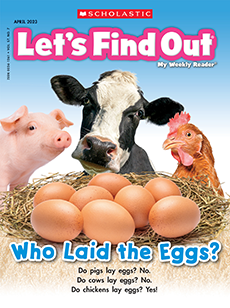A guide for using our resources
Children will examine the properties of bubbles.
Vocabulary: esfera, explotar, iridiscente, película
Science Focus: properties of matter
Simple, spectacular ideas to boost your lessons.
Paired Text: Burbujas by Ben Clanton
Paired Text: Burbujas by Ben Clanton
- Narval and Medu play with bubbles under the sea. From the author of the Narval y Medu book series, this cardboard book is perfect for students to practice their reading skills.
Mini-Experiment: Prueba las formas de las burbujas
Mini-Experiment: Prueba las formas de las burbujas
- Are bubbles always round? Test it out! Help kids shape bubble wands from pipe cleaners. In addition to a round wand, make a square wand, a triangular wand, or any other shape you like.
- Use your wands with bubble solution (to make your own, see the hands-on activity below). Before kids blow their bubbles from each wand, have them predict what shape the bubbles will be. They will see that no matter what shape the wand is, the bubbles are always round!
Scavenger Hunt: Páginas 2-3
Scavenger Hunt: Páginas 2-3
- Use pages 2-3 of the issue to do this scavenger hunt as a group.
- Encuentra la imagen con una burbuja estirada. Márcala con un ✓.
- En el cuadro violeta, encuentra la palabra que signifi ca “romper”. Rodéala.
- Encuentra el titular. Subráyalo.
- Mira la barra al fi nal. Rodea la palabra iridiscente cada vez que aparezca.
Hands-on Activity: Haz tu propia solución de burbujas
Hands-on Activity: Haz tu propia solución de burbujas
Skill: making observations
Materials: empty two-liter bottle, dish soap, corn syrup, bubble wands
- Kids can learn a whole lot of science while making their own bubbleblowing solution!
- Fill the bottle three-quarters of the way with water and then add a halfcup of dish soap. Test the solution by trying to blow bubbles with it. (It won’t work.) Discuss why it’s not working—the soapy water isn’t thick enough. It’s not strong enough to wrap itself around the air without breaking.
- Now pour a half-cup of corn syrup into the mixture, pointing out that the syrup is thicker than water. Let the syrup dissolve. (You can close the bottle and shake it, or let it sit in the sun for a while.)
- Test the solution again. Now children can blow bubbles! That’s because the corn syrup helped increase the surface tension of each bubble, making it strong enough to hold the air inside.
